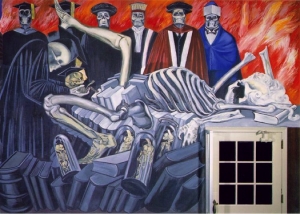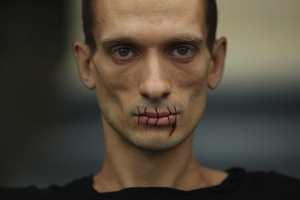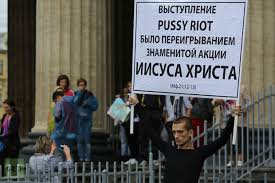Skeletal Birth
The Epic of American Civilization: God's of the Modern World
Jose Clemente Orozco (1932-34)
The obsessive crave for knowledge has driven humanity out of society. Starting the moment children utter their first words, information has been crammed into their delicate brains, forcing the consumption of excessive knowledge with hopes of future success. In the past, learning was a privilege not available to many. Now, it is mandated and extremely common to a point where without an education, success is near impossible. Many aspiring musicians, artists and writers have turned from the humanities to achieve perfect grades and test scores and fulfill what society has defined as success. Humanity has been lost by the automatic, colorless educational system that restricts personal thoughts, ideas and imagination. This sad reality is captured in Jose Clemente Orozco’s last panel The Gods of the Modern World in his collection under Dartmouth College Library.
With the confusion of bones and dark robes, the first noticeable difference between this panel and the neighboring one is the bright background. The strokes of slightly varied shades of red, orange, yellow and white mimic that of a flickering fire. Orozco paints fires multiple times throughout this mural; in the background of the panel depicting Cortez’s overtaking of the land, there is war, destruction, and a burning fire consuming the ships. With the background of flames, Orozco suggests that an oppressive educational system causes the destruction of humanity. The fire may have consumed the flesh and life from these characters, leaving only dead skeletons to perform human actions.
Closest to the flames, stands the Gods of the Modern World where Orozco illustrates six men who are purveyors of false knowledge. This interpretation stems from the fact that though these skeletons dress as men, underneath the robes signifying high class, education and status, they are all merely bones. Through these false figures of power, Orozco suggests that even though education is intended to foster change and improvement of the failing society, it does nothing more than fuel the flames of greed, power and deceit. It is important to note the progressive addition of color from the first skeleton on the far left to the last one the right portrays that even with growing status and control, each man is a dead skeleton underneath. Interestingly, each “human” is adorned with a specific hat; the youngest and least colorful start with a standard graduation cap and as the clothing complicates, the design of the headwear does as well. Even the woman lying down has hair on her head, which is the simplest, least dimensional headpiece of all the characters. The most vulnerable and exposed, she may represent the impoverished and cheated in society. This symbolizes the superficial nature of people because materialistic goods measure status and power.
Aesthetically, the pop of red and especially blue on the right brings the spectators’ attention to the depiction of the woman giving birth on the foreground of the panel. The scene of a scholar holding a skeletal fetus and a woman who looks as if she just gave birth is, undoubtedly, one of the most controversial sections of the entire mural. Not only does it expose a vulnerable, precious moment to most mothers and families, but it also twists this moment to depict a scene of death, which is often symbolized by skeletons. By redefining this moment of life as one full of death, Orozco criticizes the educational system for staining such pure experiences with worries of the newborn’s education, success and future. Rather than expressions of joy from the scholar, mother or those spectating, the characters are stolid and expressionless. The mother, unlike the others, seems to be in pain and has her eyes covered by wisps of old white hair. She is the only skeleton that isn’t dressed as a scholar, and has a human quality: hair. This may be a testament to the ignored and overlooked pain of society, disregarded by the scholars who are watching expressionless even though they are educated on how to combat the problems. However amidst the dark notes of this panel, the gray novels support the woman and the skeletal fetus, which parallels the support a strong education provides. Though most of this panel is a critique of the educational system, Orozco understands that a strong education is fundamental and provides support to those who invest in it.
After two years of sketching, plastering and painting, Orozco decided to finish his masterpiece mural with this panel. His motives are questioned, as it seems to be a morbid ending to the story of civilization Orozco attempts to depict. But perhaps, the bones and flames are a symbol of rebirth, telling of the new intellectual times ahead.
Mestizo Mexico
Creation
Jose Vasconcelos ( 1922)
Fixed tradition is an integral part of Mexican culture, but the beliefs that unite its people are fluid. In sixteenth-century Mexico, the term “mestizo” was often used to describe children born of out wedlock. This derogatory connotation of bastardry stuck with the phrase until the early 20th century when leaders like Jose Vasconcelos, Miguel Hidalgo and Pavon rallied the fight for Mexican independence from Spain. Mestizos throughout the country started anew as the label became one that instead represented dignity, pride and nationalism. There was no longer shame in the fact that the majority of the country was of mixed races; a single race could exist uniting the Europeans, Indigenous people and Mexicans. Possibly the most influential man in this unifying movement was Jose Vasconcelos. A passionate advocate of the mestizaje, he published an essay titled “La Raza Cosmica” or the Cosmic Race in which he describes his belief that the bronze race would conquer the world. At a time when racial theories were rising—a decade later Hitler would impose his view of Aryan superiority—Vasconcelos stressed the importance of another color, bronze, as a symbol for mixed ethnicity (Ilan Stanvans, The United States of Mestizo).
This changing mestizaje culture is well depicted in the work of twentieth century Mexican artists such as Diego Rivera, Jose Clemente Orozco and David Alfaro Siqueiros. Many of their murals carry the same motif in which the past is illustrated with chaos and a clash of civilizations, while the present depicts an attempted balance between ethnicities and nations. Additionally, the Mexican revolutionaries described in Mariano Azuela’s The Underdogs believed in the power of the mixed race.
The Underdogs follows the life of Demetrio Macias, a peasant who abandons his family to flee from government soldiers and forms a group of rebels that supports the Mexican Revolution. One of the leaders of this revolution was Pancho Villa, a strong general that was born of mixed blood and thus considered mestizo. Loved, revered and respected by all that followed him, Villa was a beacon of hope to these men who felt oppressed by the Mexican government. As a mestizo, Pancho Villa unified men of different races to fight for a common cause: liberation from the dictatorship. It is significant that Villa was so well liked and respected regardless of the fact that he was not of pure Mexican descent. This illustrates that not only did his strong motives carry the nation to freedom, but also that his mestizo identity lead the people to a constitutional republic. This support of Pancho Villa is evident when Luis Cervantes and other men heard of his arrival. Once they found out, “the news spread as quickly as lightning. Ah, Villa! The magic name. The profile of a great man; the unconquerable warrior who even from a distance exerts the fascination of a great boa. ‘Our Mexican Napoleon!’ Luis Cervantes exclaimed… ‘No one goes hungry when they’re with Villa. Their wagons are full of oxen, sheep, cows. Cars with clothes. Trains packed with equipment, supplies and weapons. And enough food for everyone to eat till they’re stuffed’”(P65). They revere Villa as a hero to their cause and his invincibility drives them to fight for and along the great man. Most importantly, Pancho Villa claims the mestizo identity as his own and in doing so, the mestizaje throughout the country lead the revolution alongside him.
The unity of the bronze race, and its influence during the Mexican Revolution are also demonstrated in Desmond Rochfort’s Mexican Muralists in the work of Diego Rivera. In 1923, Jose Vasconcelos commissioned Rivera to create a fresco in the Museo de San Idelfonso. Titled “Creation”, it is a combination of Mexican, Hellenic and Judeo-Christian beliefs that reflects Vasconcelo’s idea of the “cosmic race”. Vasconcelos advocated for and organized an extensive public art program that was geared towards creating an assimilation of the country’s diverse population into a single ethnic identity. Rivera, as depicted throughout this painting, idealized the Mexican revolution and highlighted the fact that this single identity, the mestizo, was at the forefront of political change. Interestingly, while painting this mural he carried a pistol at all times in fear of the right wing students attacking him for his progressive artwork.
The mural itself is proportioned to the pipe organ which surrounds the wall, thus the figures stand over twelve feet in height. All of the painted figures don’t look particularly European or Mexican, their neutral colored skin suggests the mestizo, or mixed race background. Additionally, the unification of the different religions and races set on a background of bright colors connotes a peaceful, harmonious unification (P35, Desmond Rochfort, Mexican Muralists). Rivera’s eclectic style was “influenced as much by Christian Renaissance iconography and Byzantine golden backgrounds as the intense fauvist palette and the formal cubist synthesis.” For a long time his style was not appreciated by a great part of the Mexican public, unfamiliar with the new freedom of artistic expression among international leaders (La Creacion by Diego Rivera, Dina Mirkin). Regardless of the negative reaction, Rivera seems to highlight the power and unity that comes with the mestizo identity, supporting the opinion that “La Raza Cosmica” was the forefront of the Mexican Revolution.
Both Diego Rivera’s fresco, “Creation” and Mariano Azuela’s The Underdogs suggest that the mestizo culture supported the efforts of Mexican revolutionaries. And though some may not have agreed with the mestizo symbolizing the Mexican Revolution, like Jose Clemente Orozco in his criticisms of the revolution, it is undeniable that the mestizo culture was an integral part to the social implications of the Mexican Revolution.
Art Will Never Stop Speaking
Public art defines the work of many different artists. Some art is created by the active participation of the public; others are single defiant acts by an impassioned creator, or lighthearted works meant to inspire joy in its viewers. Unconstrained by the architecture of a museum or a gallery, the artist is allowed to fully express his/her convictions. Because public art depends heavily on the audience, artists are commissioned, supported by the community to create beautiful pieces of artwork that prevent undesirable graffiti tagging and vandalism. Those who are not, however, sulk in the shadows, waiting for the perfect opportunity to craft a bold, conflicting statement that creates enemies. These different intentions of public artists are seen through the works of Petr Pavlensky, David Zinn and General Howe. Yet regardless of the artist’s intent, a public reaction—one that fulfills the artist’s purpose for creating the piece—is why artists continue to draw, paint, and perform.
The government fears these unpredictable, raging artists. His passion for speaking (or not speaking) out about political issues in Russia inspires Petr Pavlensky’s performance art in Moscow’s streets. Born in St. Petersburg, Pavlensky studied at Art College, which he describes as a "disciplinary institution that aims to make servants out of artists". In 2012, he dropped out of the school. After leaving the institution, he found inspiration in many artists like “Caravaggio, even though [Caravaggio] worked with canvas and oils. He had a very serious life project, though: he made works with the theme of self-harm, where he translates real events on to the bodies of his subjects. He isn't a decorative artist. I am very critical of any decorative art as an idea, the idea of ornamentalism and concealment. Everything that does the opposite, that brings things out and reveals how things actually are, this is what interests me”(Shaun Walker, Why I Nailed…). Pavlensky is well known for many of his other performance art pieces like wrapping himself naked in a coil of barbed wire, nailing his scrotum to the Red Square and cutting his earlobe while naked in public. In contrast to many unsupported artists who try to avoid the police, Pavlensky actually predicts how the police will react and incorporates their potential reaction into his artwork. So when the police react in brutality and aggression, they are becoming a part of Petr’s performance art. In this sense, the public is unknowingly commissioning the art of Pavlensky, regardless of if he’s been arrested multiple times. It seems as if the disgusted, disapproving reaction is exactly what he desires.
Figure 1
Taken by: Reuters
Petr Pavlensky, Pussy Riot Supporter and artist protests outside of Kazan Cathedral in St. Petersburg, 2012.
Figure 2
Taken by: Reuters
Petr Pavlensky, Pussy Riot Supporter and artist protests outside of Kazan Cathedral in St. Petersburg, 2012.
In stark contrast, the work of David Zinn, a chalk artist in the small town of Ann Arbor, Michigan, creates playful art pieces meant to lighten people’s days. Using only chalk, charcoal and found objects he improvises and adjusts his work based on location. His chalk work began in 2001 “as an excuse to linger outdoors, but has since achieved global notoriety through the sharing of photos on Facebook, Huffington Post UK, The Cheezburger Network, Street Art Utopia, and Archie McPhee’s Endless Geyser of Awesome”(Zinn.com). His main goal is to provide the community an opportunity to “look down and feel up”(Zinn). His work is not controversial as its’ purpose is not to inspire an outrageous response from the audience but rather to offer a cheerful, happy work that brings a grin to his viewers faces. Though he has been supported by the profit from his book, “Temporary Preserves”, he doesn’t like to receive commissions from the community, as he wants to preserve the integrity of why he started creating this art in the first place.
Figure 3
Taken by: David Zinn
Tempting the Gerbilsaurus
Though Zinn’s motives are based on creating appealing images to his viewers, General Howe’s are meant to symbolize the world’s war on apathy. As a street artist, he deliberately places small-scale plastic soldiers in historically accurate locations on the street to educate his viewers of the past and present perceptions of war. He has a deep commitment to honoring the sacrifices made by soldiers of war and he “deploys his installations to help us learn some of the history that our culture has forgotten – and hopefully draw some connections to the current wars we are engaged in”(brooklynstreetart.com). He stated,
“ I make war in Brooklyn. Did you know the Revolutionary War was fought in Brooklyn? Did you know we’re at war in Afghanistan and Iraq? It’s easy to forget we’re battling in foreign lands against invisible adversaries. I bet you know more about Call of Duty: Modern Warfare 2. This is why I make war in Brooklyn”(General Howe, 2014).
His goal is for the viewer, or participant to reflect on his/her own experiences in looking at his art. He feels that many war tragedies are easily forgotten in daily life, and hopes the community will take even a second to recognize and reflect on this through his public art. Though he is highly commended for his dedication to a goal, he has not been commissioned for his artwork. Regardless, the Brooklyn community welcomes his work with open arms, excited for his next statement piece.
General Howe
Fruits of War
2013
Brooklyn, NY





